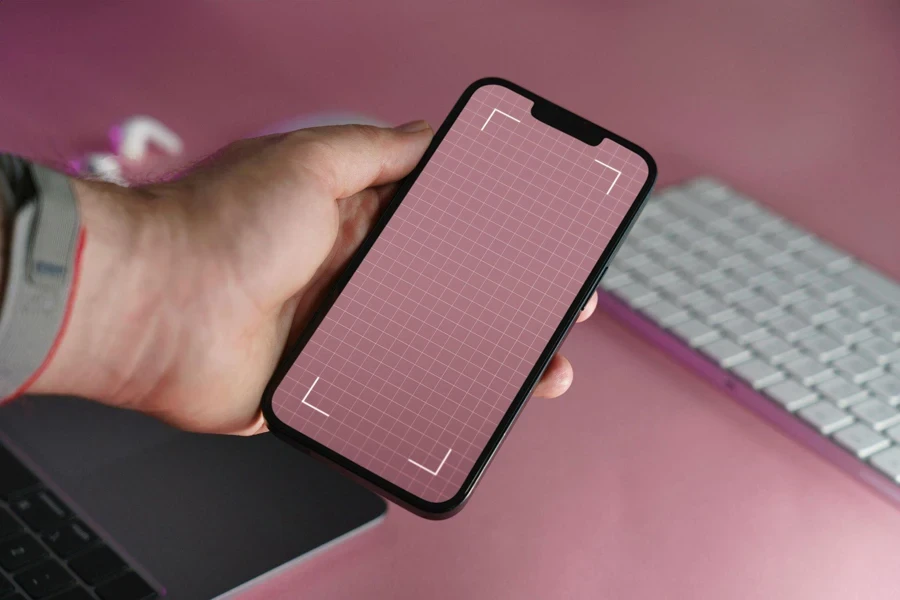In 2024, selecting the appropriate mobile phone becomes more crucial than ever due to the swift pace of technological innovation. These devices are at the core of modern business efficiency, enabling enhanced connectivity, superior computational power, and cutting-edge applications that cater to various professional needs. With the evolution of mobile technology, phones now offer capabilities that rival traditional computing devices, making them indispensable tools for professionals seeking to optimize operational capabilities and maintain competitive edges in their industries. As technology continues to advance, understanding the nuances of mobile phone features and their practical applications is essential.
Table of Contents
1. Mobile phone varieties and their applications
2. 2024 mobile phone market insights
3. Criteria for selecting mobile phones
4. Leading mobile phone models and their specifications
5. Conclusion
Mobile phone varieties and their applications

Classification of mobile phones by type
The mobile phone landscape in 2024 features a diverse array of devices tailored to specific needs and environments. Smartphones continue to dominate, providing powerful computing capabilities in compact forms suitable for general use and specialized business applications. Feature phones, although less prevalent than their smarter counterparts, remain relevant for their simplicity and durability, catering to users who require basic telephony and messaging without the frills. The advent of foldable phones has introduced new dynamics into the market, combining portability with expansive screen real estate, ideal for professionals who multitask on the go. Rugged devices are engineered to withstand harsh conditions, making them indispensable in industries like construction and outdoor services where exposure to elements is a common concern.
Typical uses across different segments
Each category of mobile phone serves distinct segments, bringing tools and functionalities tailored to the needs of its users. Smartphones, equipped with advanced cameras and robust processing capabilities, are invaluable for professionals in creative fields like photography and digital marketing, where content creation and media consumption are frequent. For executives and field workers, smartphones also offer extensive software ecosystems that include business applications for project management and communication. Feature phones serve those in need of long battery life and robust build, often used in areas where more advanced technology is superfluous or too costly. Foldables provide a bridge between mobile phones and tablets, offering a versatile option for professionals who need larger screens for presentations or detailed analysis without sacrificing mobility. Rugged phones, with their enhanced durability features, support users in extreme environments, ensuring connectivity and functionality in situations where conventional smartphones would falter.
This comprehensive range of mobile phones in 2024 allows for optimal alignment of device capabilities with professional requirements, ensuring that every segment of the market is equipped with the tools necessary for their specific operations and environments. As technology evolves, so too does the integration of these devices into various professional landscapes, highlighting the critical role they play in both individual productivity and broader operational efficacy.
2024 mobile phone market insights

Evolution of mobile phone technologies
The landscape of mobile phone technology in 2024 is marked by significant advancements that reflect the fast-paced evolution of the industry. Artificial intelligence (AI) has become a cornerstone in mobile technology, with new devices integrating AI to enhance user interactions and automate more processes, thus making phones more intuitive and responsive. Leading devices now feature advanced AI-driven camera systems that not only improve image and video quality but also introduce features like real-time content editing and enhanced scene recognition. Furthermore, the integration of AI has extended to battery management systems, optimizing device performance and energy consumption based on user behavior patterns.
Experts currently value the global smartphone market at approximately 289.4 million units shipped in the first quarter of 2024, and they observe a positive growth trajectory. They estimate this growth will continue at a 7.8% compound annual growth rate (CAGR) for subsequent quarters as the market recovers from previous economic challenges.
Market dynamics and consumer preferences
As for market dynamics, the shift toward 5G technology has accelerated, with a notable increase in the adoption of 5G phones across various markets. This transition is driven by the demand for faster data speeds and more reliable network connections, which are essential for the increasingly digital and mobile-first world. Additionally, there is a growing consumer preference for devices that promote sustainability. Manufacturers are responding by incorporating eco-friendly materials and processes into their production lines, which not only appeals to environmentally conscious consumers but also aligns with global sustainability goals. Another notable trend is the demand for more compact design, which has led to the development of smaller, more efficient components that allow for sleeker and lighter devices without compromising on performance.
These trends underline a market that is increasingly centered on providing technologically sophisticated solutions that cater to a broad spectrum of professional and personal needs. The convergence of high-speed connectivity, enhanced usability through AI, and a commitment to sustainability represents a significant transformation in the mobile phone sector, poised to influence both consumer choice and industry standards moving forward.
Criteria for selecting mobile phones

Key features to consider
When selecting mobile phones, certain features stand out as critical for ensuring that the devices meet the high demands of contemporary business operations. Battery life remains a paramount concern, with professionals requiring devices that can last through extended work hours without frequent recharging. Modern mobile phones are increasingly equipped with batteries that not only last longer but also charge more rapidly, often incorporating fast-charging technologies that can deliver hours of use with just a few minutes of charging.
Processing power is another crucial aspect, as it determines the phone’s ability to run complex applications and multitask efficiently without lag. With the advent of 5nm and 7nm chip technologies, top-tier smartphones now boast desktop-level processing capabilities, enabling everything from high-speed data analysis to advanced graphical presentations on the go.
Camera quality has also become a significant factor, especially with the rise of visual content in marketing and communication strategies. The latest devices offer multi-lens camera systems with features like optical zoom, high-resolution sensors, and AI-enhanced image stabilization, allowing for professional-quality photography and videography.
Operating system updates are vital for maintaining security and functionality. Phones that receive regular updates are preferred, as these updates ensure protection against the latest cyber threats and introduce new features that enhance productivity and user experience.
Impact of connectivity options
Connectivity is a cornerstone of mobile phone functionality, impacting everything from simple call quality to high-speed internet access. 5G has become the benchmark in mobile connectivity, offering unprecedented download and upload speeds that facilitate instant cloud access, real-time communication, and smooth streaming of high-definition content. This is particularly beneficial for professionals who require reliable and fast internet access while working remotely or traveling.
Other connectivity features like Wi-Fi 6 support, Bluetooth 5.2, and NFC (Near Field Communication) also play significant roles in enhancing user experience by improving the speed and reliability of wireless connections and enabling interactions with a range of devices and services.
Together, these features form the backbone of a solid mobile phone selection strategy in 2024, equipping professionals with the tools necessary for efficiency and connectivity in an increasingly digital and fast-paced business environment. Each feature contributes to a seamless blend of performance, convenience, and security, marking the evolution of mobile devices into essential business tools.
Leading mobile phone models and their specifications

Analysis of Top Models for 2024
The mobile phone market in 2024 showcases some exceptional models that highlight the pinnacle of current technology. Here’s a deeper look into five standout models that exemplify the best in their categories:
Apple iPhone 15 Pro Max: Known for its robust ecosystem and cutting-edge technology, the iPhone 15 Pro Max introduces a groundbreaking A17 Pro chipset that significantly enhances processing power and efficiency. This model debuts Apple’s first periscopic telephoto lens, offering a 5x optical zoom that transforms mobile photography with superior clarity and detail from farther distances. It also features a ceramic shield more resistant to drops and scratches, catering to the premium segment with a price starting at $1,199.
Samsung Galaxy S24 Ultra: This device is a favorite among tech enthusiasts for its versatile capabilities and superior display. Equipped with the Snapdragon 8 Gen 3 chip, it delivers top-tier performance with a focus on graphics and AI enhancements. The Galaxy S24 Ultra’s expansive 6.8-inch AMOLED display supports a 120Hz refresh rate, ideal for smooth scrolling and vivid visuals. Its camera setup includes a new 200MP main sensor that offers unparalleled photo and video quality, priced at $1,299.
Google Pixel 8 Pro: Google’s Pixel 8 Pro is celebrated for its sophisticated AI integrations powered by the Tensor G3 chip, making it highly efficient at photo processing and real-time language translation. Its camera system, although less robust in hardware than some competitors, leverages software to produce stunningly clear and color-accurate photos. This device is particularly noted for its astrophotography capabilities, allowing users to capture the night sky in exceptional detail. It is priced competitively at $999.
OnePlus 12: Emerging as a strong contender, the OnePlus 12 offers a balance of performance and price. It features a Snapdragon 8 Gen 3 processor, similar to the Galaxy S24 Ultra, but at a lower price point of $899. The device boasts a 6.7-inch AMOLED display with a 120Hz refresh rate and a versatile triple camera setup that provides excellent photographic capabilities without the premium cost.
Motorola Edge 30 Ultra: This model stands out for its value proposition, featuring a 6.7-inch OLED display and a dynamic 144Hz refresh rate that’s perfect for gaming and high-speed content consumption. The Edge 30 Ultra is powered by a Snapdragon 8 Gen 2 processor, ensuring fast and responsive performance across all applications. Its 200MP main camera competes directly with high-end models, offering professional-quality photos at a more accessible price point of $799.
Each of these models demonstrates a commitment to pushing the boundaries of what mobile phones can do, from their processors to camera technologies and display innovations. For business professionals and tech enthusiasts, choosing among these devices will largely depend on specific needs such as photographic capabilities, processing power, or the ecosystem connectivity that enhances productivity and user experience.
Comparative Analysis of Best Models for 2024
Display and Design:
- Apple iPhone 15 Pro Max features a 6.7-inch Super Retina XDR display, renowned for its color accuracy and brightness, catering to professionals who value visual detail and vibrancy.
- Samsung Galaxy S24 Ultra pushes the boundaries with its 6.8-inch Dynamic AMOLED 2X display, offering a 120Hz refresh rate which is ideal for high-definition video streaming and gaming, providing an immersive viewing experience with deep blacks and vibrant colors.
- Google Pixel 8 Pro maintains a balance with a 6.4-inch AMOLED display that offers exceptional color accuracy and HDR capabilities, suitable for users who appreciate fidelity in media consumption.
- OnePlus 12 sports a 6.7-inch Fluid AMOLED display with a 120Hz refresh rate, providing smooth scrolling and responsiveness that appeals to both gamers and everyday users.
- Motorola Edge 30 Ultra stands out with its 6.7-inch OLED display with a 144Hz refresh rate, the highest in this group, which delivers ultra-smooth motion clarity, making it a favorite for high-speed gaming and dynamic content viewing.
Performance and Processing Power:
- Apple iPhone 15 Pro Max is powered by the A17 Pro chipset, designed for efficient multi-tasking and handling of heavy computational tasks without lag, suitable for professional applications and high-end gaming.
- Samsung Galaxy S24 Ultra features the Snapdragon 8 Gen 3 processor, known for its robust performance in AI processing and augmented reality applications, making it ideal for tech enthusiasts.
- Google Pixel 8 Pro utilizes the Tensor G3 chip which optimizes AI-driven operations, enhancing user interactions with intelligent features like real-time translation and adaptive battery life.
- OnePlus 12 also uses the Snapdragon 8 Gen 3, offering similar performance to the Samsung but at a lower price point, making it a value-for-money option for power users.
- Motorola Edge 30 Ultra leverages the slightly older Snapdragon 8 Gen 2, providing ample power for everyday tasks and moderate gaming, positioned as a budget-friendly alternative for cost-conscious consumers.
Camera Capabilities:
- Apple iPhone 15 Pro Max introduces a periscopic telephoto lens with 5x optical zoom, enabling professional-grade photography that captures far-off subjects in crisp detail, supplemented by advanced computational photography features.
- Samsung Galaxy S24 Ultra boasts a 200MP main camera sensor for unprecedented detail and a versatile camera setup that includes ultra-wide and periscope zoom lenses, catering to photography enthusiasts and professionals alike.
- Google Pixel 8 Pro, while having a lower megapixel count, excels in software optimization, providing features such as Night Sight and astrophotography that produce superior images in low-light conditions.
- OnePlus 12 offers a competent triple camera system that performs well across various lighting conditions, providing flexibility with its combination of main, ultra-wide, and telephoto lenses.
- Motorola Edge 30 Ultra impresses with its 200MP sensor, matching Samsung’s detail but at a lower price point, making it an excellent option for users who prioritize photographic capability without a premium cost.
Price and Value:
- Apple iPhone 15 Pro Max is the most expensive at $1,199, justified by its top-tier ecosystem, cutting-edge technology, and longest software support lifespan.
- Samsung Galaxy S24 Ultra follows closely at $1,299, offering arguably the best screen and camera technology in the smartphone market.
- Google Pixel 8 Pro stands at $999, providing the best value for users who seek advanced AI features and consistent Android updates.
- OnePlus 12 is priced at $899, striking a balance between high-end features and affordability, appealing to a broad user base.
- Motorola Edge 30 Ultra is the most affordable at $799, making it accessible to users who need high performance and excellent camera quality without breaking the bank.
This comparative analysis underscores the unique strengths and niches of each model, helping consumers and business professionals make informed decisions based on their specific needs and budgets. Whether it’s for professional photography, high-speed gaming, or everyday efficiency, there’s a model in this lineup that meets the criteria, offering a range of options in the ever-evolving smartphone market.
Conclusion
The selection of mobile phones in 2024 hinges on a detailed understanding of each model’s capabilities and how they align with professional requirements. This analysis has highlighted the importance of key features such as display quality, camera capabilities, processing power, and connectivity options across leading devices like the iPhone 15 Pro Max, Samsung Galaxy S24 Ultra, and Google Pixel 8 Pro. For business professionals, making an informed choice involves weighing these factors to find a device that not only meets but enhances daily operational efficiency and keeps pace with technological advancements.




